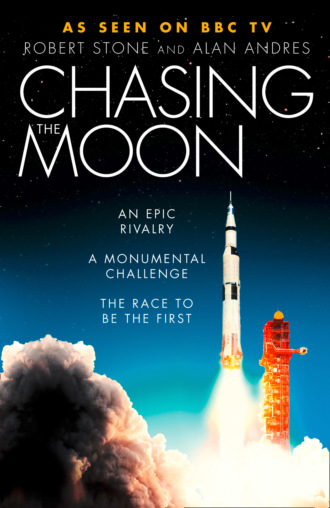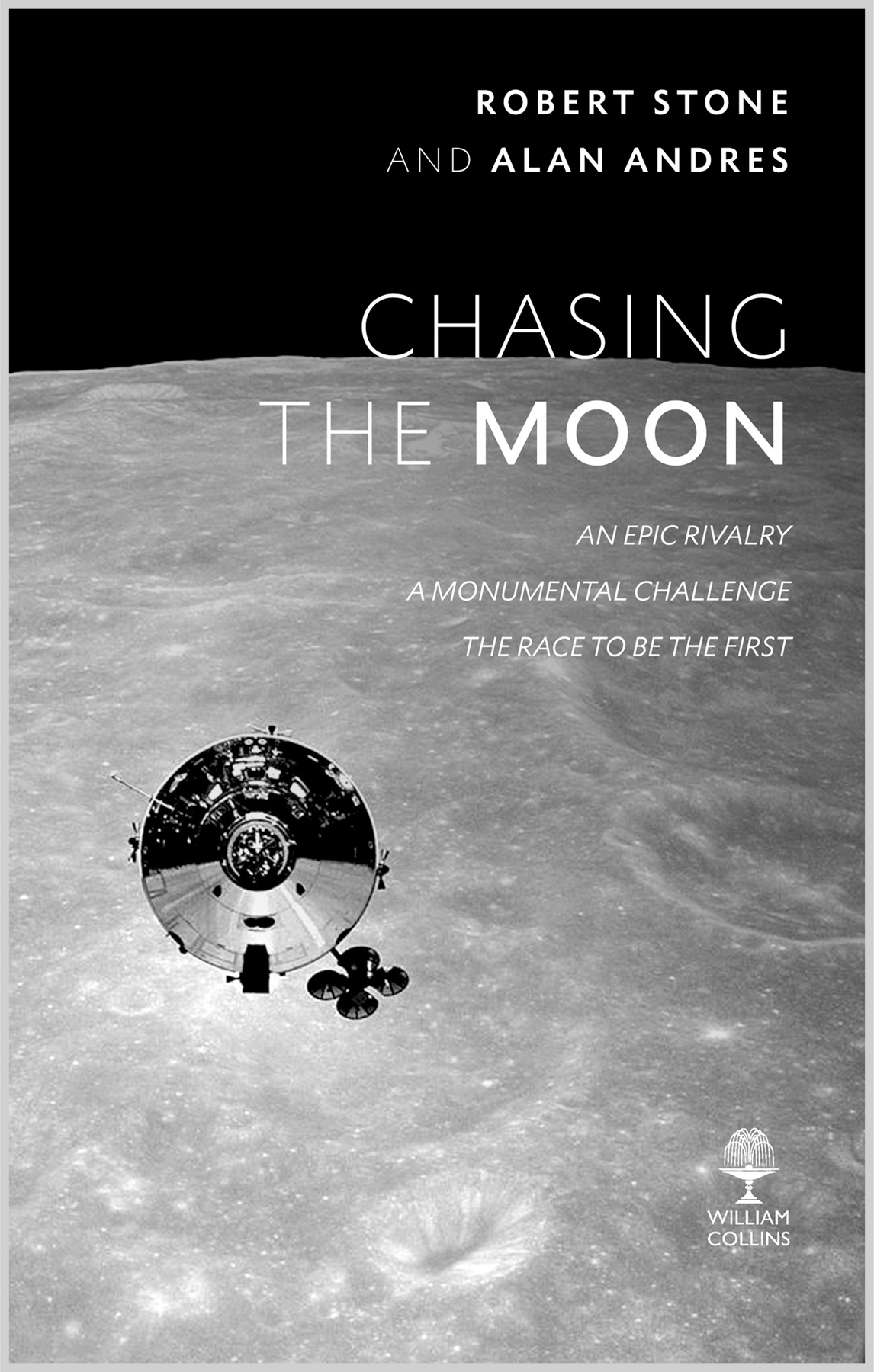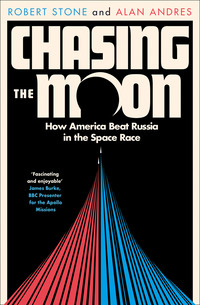
Полная версия
Chasing the Moon: The Story of the Space Race - from Arthur C. Clarke to the Apollo landings


COPYRIGHT
William Collins
An imprint of HarperCollinsPublishers 1 London Bridge Street London SE1 9GF WilliamCollinsBooks.com
This eBook first published in Great Britain by William Collins in 2019
First published in the United States by Ballentine Books, an imprint of Random House, a division of Penguin Random House, LLC, New York
Copyright © Alan Andres and Robert Stone
Insert photos courtesy of NASA unless otherwise indicated
“AMERICAN EXPERIENCE”™ is a trademark of the WGBH Educational Foundation.
Used with permission
Grateful acknowledgement is made to Tom Lehrer for permission to reprint an excerpt from “Wernher von Braun” by Tom Lehrer, copyright © 1965 by Tom Lehrer. Reprinted by permission of the author
Alan Andres and Robert Stone assert the moral right to be identified as the authors of this work in accordance with the Copyright, Designs and Patents Act 1988.
Cover image © Getty Images
A catalogue record for this book is available from the British Library.
All rights reserved under International and Pan-American Copyright Conventions. By payment of the required fees, you have been granted the non-exclusive, non-transferable right to access and read the text of this e-book on-screen. No part of this text may be reproduced, transmitted, down-loaded, decompiled, reverse engineered, or stored in or introduced into any information storage and retrieval system, in any form or by any means, whether electronic or mechanical, now known or hereinafter invented, without the express written permission of HarperCollins.
Source ISBN: 9780008307875
eBook Edition © June 2019 ISBN: 9780008307851
Version: 2019-05-30
For my mother, who awakened her ten-year-old son in the middle of an English midsummer night to watch Neil Armstrong and Buzz Aldrin make history as they walked on the Moon.
—R.S.
For Charlie, older brother and teenage rocket scientist, who, as the youngest accredited journalist covering the launch of Apollo 14, backpacked and hitchhiked 1200 miles to Cape Kennedy.
— A.A.
CONTENTS
COVER
TITLE PAGE
COPYRIGHT
DEDICATION
PROLOGUE JULY 16, 1969
CHAPTER ONE A PLACE BEYOND THE SKY (1903–1950)
CHAPTER TWO THE MAN WHO SOLD THE MOON (1952–1960)
CHAPTER THREE THE NEW FRONTIER (1961–1963)
CHAPTER FOUR WELCOME TO THE SPACE AGE (1964–1966)
CHAPTER FIVE EARTHRISE (1967–1968)
CHAPTER SIX MAGNIFICENT DESOLATION (1969)
CHAPTER SEVEN THE FINAL FRONTIER (1970–1979)
APPENDIX AFTER A FEW MORE REVOLUTIONS AROUND THE SUN
PICTURE SECTION
ACKNOWLEDGMENTS
NOTES
INDEX
ABOUT THE AUTHORS
ABOUT THE TYPE
ABOUT THE BOOK
ABOUT THE PUBLISHER
PROLOGUE
JULY 16, 1969
THE SUN BEGAN rising over the northeast coast of Florida on what would be a humid subtropical mid-July morning. The brown pelicans swooping over the dunes sensed the day was anything but typical. Parked tightly together on the sides of the narrow roads to the beaches and causeways were thousands of cars and campers. The air carried the thrumming sound of helicopters ferrying visitors to the Kennedy Space Center. Since shortly after sunrise, all the roads to the Cape had become clogged with traffic.
Nearly a million people were gathering under the harsh Florida sun to witness the departure of the first humans to attempt a landing on another world, the Earth’s moon, 239,000 miles away. Should it be successful, the piloted lunar landing would culminate a decade of mounting anticipation.
Eight years earlier, President John Kennedy stood before Congress and called for the United States to put a man on the Moon and return him safely to Earth before the end of the decade. At the time, the Soviet Union’s commanding position in space appeared assured. They had been the first to launch an artificial satellite, the first to fly past the Moon, and, in a one-hundred-eight-minute flight, the first to orbit a human around the Earth. When Kennedy addressed Congress, the suborbital flight of the only American to venture into space had been less than fifteen minutes.
But by July 1969, as America readied to launch Apollo 11 from the space center bearing the name of the late president, the Soviet space threat had receded. This would be the twenty-first piloted NASA space mission; in comparison, the Russian total was twelve, and all had remained in low earth orbit. Now the richest nation on Earth was about to undertake a daring technological feat of unprecedented magnitude, a demonstration of national will framed as a world media event. It was a story of courage, adventure, and scientific exploration as well as an exercise in geopolitics.
If not for the persuasive influence of a select group of visionaries, this moment in history would have been inconceivable. For some it was the fulfillment of a personal dream dating back to childhood. For others it was a way to promote democracy, extend human knowledge, and establish the nation’s technological and academic preeminence. Some saw it as humanity’s inevitable evolutionary destiny; others their personal patriotic duty.
A few hundred feet south of the giant Vehicle Assembly Building, where the Saturn V moon rocket had been put together, a balding middle-aged Englishman dressed in a gray suit looked toward the launchpad from CBS News’s temporary broadcast facility. Arthur C. Clarke had imagined this day since his teenage years, having co-authored one of the first serious publications about a possible expedition to the Moon. He was scheduled to appear on live television with CBS’s veteran newsman Walter Cronkite shortly after Apollo 11’s liftoff. During the preceding year, Clarke’s reputation as a leading author of science fiction had risen to greater prominence due to his association as co-writer of director Stanley Kubrick’s 2001: A Space Odyssey, the top-grossing film of 1968. For Clarke, the moon landing would establish the extraterrestrial presence of Homo sapiens in the cosmos, with a promise of what the human race might achieve in the future.
At the same moment, in NASA’s Launch Control Center, a few hundred feet away from the press center, Wernher von Braun also looked toward the launchpad, three and a half miles away. One of the most famous men in America, the tall, handsome German-born rocket engineer trained his field glasses on the 365-foot-tall Saturn V. Designed by a team under his direction, it was the most powerful rocket in the world. Much like his friend Arthur Clarke, von Braun had his fascination with space travel ignited at an early age by reading science fiction.
A decade earlier the German had been hailed a national hero following the successful launch of the United States’s first satellite. A master salesman, von Braun had a unique skill, persuading powerful decision makers—senators, presidents, generals, and dictators—to give him whatever he needed to build his powerful rockets to explore space. However, despite his renown and having lived in the United States for nearly a quarter century, questions surrounding von Braun’s past continued to shadow him. During World War II, he had overseen the creation of the first long-range guided ballistic missile for Adolf Hitler’s Third Reich. This portion of his biography was well known and had even served as the basis for a Hollywood feature film, but despite having addressed it repeatedly in the past, von Braun and his wartime career in particular remained controversial and open to occasional speculation.
Adjacent to both the designated press area and the Launch Control Center were a few simple wooden bleachers, not unlike those found alongside a typical high school football field. This was NASA’s VIP viewing area, the most coveted location on Cape Kennedy, despite its lack of shade on this sweltering July morning. Ambassadors, senators, congressmen, corporate heads, authors, and celebrities had begun assembling there less than an hour before Apollo 11’s scheduled liftoff time at 9:32 A.M.
Press photographers had trained their lenses on comedian Jack Benny and the popular host of The Tonight Show, Johnny Carson, when their attention was diverted by the arrival of former president Lyndon Johnson and his wife, Lady Bird. This was a rare public appearance for Johnson, one of his first since departing the White House six months earlier. Though the name of President Kennedy would always be linked to the national initiative to place a man on the Moon, Johnson’s role as chairman of the National Space Council while vice president and later during his presidency was nearly as decisive.
Johnson climbed the bleachers, stopping to greet old Washington colleagues. Near the top of the stand was Army chief of staff General William Westmoreland, until recently commander of the half million American troops in Vietnam. Directly behind President Johnson and Lady Bird was seated a man far less recognizable to the general public but the one person the former president had relied upon to make this day a reality. Unlike the astronauts or von Braun, former NASA administrator James Webb had never appeared on the cover of a national magazine or been given extensive television exposure. But Webb had been the unwavering choice of both presidents Kennedy and Johnson as the best person to run the American space program during its most challenging and transformative years.
When Americans heard Kennedy’s 1961 proposal for a hugely ambitious lunar program, they were uncertain precisely how NASA might accomplish this task and what its final expense might be. The rockets, the spacecraft, and much of the supporting technology to achieve this goal on schedule had to be invented and refined before the end of the decade. No less a space visionary than Clarke and von Braun, James Webb combined insight from his experience running a major federal government agency with years of management experience as a corporate executive. Under his leadership through most of the 1960s, NASA had accomplished a series of spectacular space milestones and had overcome a devastating tragedy that had threatened to end the moon program, only to arrive at this day.
Nearly seven thousand names appeared on NASA’s official VIP list; however, far fewer were present in the viewing stands. Notably absent were two prominent Washington politicians. President Kennedy’s only surviving brother, Senator Edward Kennedy of Massachusetts, had chosen to view the launch from the congressional offices in Washington. President Richard Nixon was also in Washington, watching the event on television at the White House with Frank Borman, the astronaut who months earlier had commanded the riskiest space mission ever attempted, the first human voyage to the Moon. Nixon had wanted to dine with the astronauts at the Cape the evening before the launch, but the plan had been canceled by the flight surgeon, ostensibly to limit the astronauts’ exposure to germs prior to their departure.
At Cape Kennedy and around the world, as the countdown clock reached zero, time seemed to stand still. Millions watching the live television broadcast held their breath and trained their eyes on the picture coming from Pad 39A. Held down by four massive arms at the base of the pad, the Saturn V trembled as its massive engines began to fire, soon building to a combined force of 7.6 million pounds of thrust, at which point the quartet of restraining mechanisms released their grip simultaneously. Three and a half miles away, those assembled began to hear the delayed rumble of the engines as they increased in volume and to feel a steadily building vibration through the soles of their feet.
Slowly lifted on a blinding pillar of fire, the Saturn V began to ascend heavenward as it fought to escape the gravitational confines of the Earth. The people watching carried within their genetic code an inherited biological disposition to dream of a better future and persevere against difficulties and constraints that could seem as daunting as the natural forces pulling against the combined power of the Saturn’s engines. The hope and aspirations of countless previous generations had powered the human chronicle to reach this moment invested with so much promise.
Конец ознакомительного фрагмента.
Текст предоставлен ООО «ЛитРес».
Прочитайте эту книгу целиком, купив полную легальную версию на ЛитРес.
Безопасно оплатить книгу можно банковской картой Visa, MasterCard, Maestro, со счета мобильного телефона, с платежного терминала, в салоне МТС или Связной, через PayPal, WebMoney, Яндекс.Деньги, QIWI Кошелек, бонусными картами или другим удобным Вам способом.


